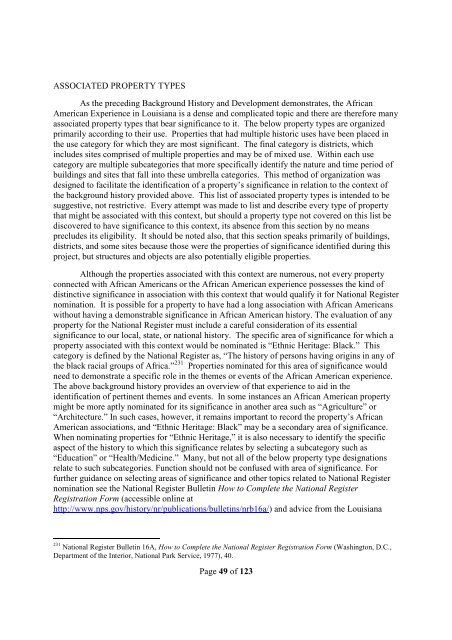The African American Experience in Louisiana
The_African_American_Experience_in_Louisiana
The_African_American_Experience_in_Louisiana
- No tags were found...
You also want an ePaper? Increase the reach of your titles
YUMPU automatically turns print PDFs into web optimized ePapers that Google loves.
ASSOCIATED PROPERTY TYPES<br />
As the preced<strong>in</strong>g Background History and Development demonstrates, the <strong>African</strong><br />
<strong>American</strong> <strong>Experience</strong> <strong>in</strong> <strong>Louisiana</strong> is a dense and complicated topic and there are therefore many<br />
associated property types that bear significance to it. <strong>The</strong> below property types are organized<br />
primarily accord<strong>in</strong>g to their use. Properties that had multiple historic uses have been placed <strong>in</strong><br />
the use category for which they are most significant. <strong>The</strong> f<strong>in</strong>al category is districts, which<br />
<strong>in</strong>cludes sites comprised of multiple properties and may be of mixed use. With<strong>in</strong> each use<br />
category are multiple subcategories that more specifically identify the nature and time period of<br />
build<strong>in</strong>gs and sites that fall <strong>in</strong>to these umbrella categories. This method of organization was<br />
designed to facilitate the identification of a property’s significance <strong>in</strong> relation to the context of<br />
the background history provided above. This list of associated property types is <strong>in</strong>tended to be<br />
suggestive, not restrictive. Every attempt was made to list and describe every type of property<br />
that might be associated with this context, but should a property type not covered on this list be<br />
discovered to have significance to this context, its absence from this section by no means<br />
precludes its eligibility. It should be noted also, that this section speaks primarily of build<strong>in</strong>gs,<br />
districts, and some sites because those were the properties of significance identified dur<strong>in</strong>g this<br />
project, but structures and objects are also potentially eligible properties.<br />
Although the properties associated with this context are numerous, not every property<br />
connected with <strong>African</strong> <strong>American</strong>s or the <strong>African</strong> <strong>American</strong> experience possesses the k<strong>in</strong>d of<br />
dist<strong>in</strong>ctive significance <strong>in</strong> association with this context that would qualify it for National Register<br />
nom<strong>in</strong>ation. It is possible for a property to have had a long association with <strong>African</strong> <strong>American</strong>s<br />
without hav<strong>in</strong>g a demonstrable significance <strong>in</strong> <strong>African</strong> <strong>American</strong> history. <strong>The</strong> evaluation of any<br />
property for the National Register must <strong>in</strong>clude a careful consideration of its essential<br />
significance to our local, state, or national history. <strong>The</strong> specific area of significance for which a<br />
property associated with this context would be nom<strong>in</strong>ated is “Ethnic Heritage: Black.” This<br />
category is def<strong>in</strong>ed by the National Register as, “<strong>The</strong> history of persons hav<strong>in</strong>g orig<strong>in</strong>s <strong>in</strong> any of<br />
the black racial groups of Africa.” 231 Properties nom<strong>in</strong>ated for this area of significance would<br />
need to demonstrate a specific role <strong>in</strong> the themes or events of the <strong>African</strong> <strong>American</strong> experience.<br />
<strong>The</strong> above background history provides an overview of that experience to aid <strong>in</strong> the<br />
identification of pert<strong>in</strong>ent themes and events. In some <strong>in</strong>stances an <strong>African</strong> <strong>American</strong> property<br />
might be more aptly nom<strong>in</strong>ated for its significance <strong>in</strong> another area such as “Agriculture” or<br />
“Architecture.” In such cases, however, it rema<strong>in</strong>s important to record the property’s <strong>African</strong><br />
<strong>American</strong> associations, and “Ethnic Heritage: Black” may be a secondary area of significance.<br />
When nom<strong>in</strong>at<strong>in</strong>g properties for “Ethnic Heritage,” it is also necessary to identify the specific<br />
aspect of the history to which this significance relates by select<strong>in</strong>g a subcategory such as<br />
“Education” or “Health/Medic<strong>in</strong>e.” Many, but not all of the below property type designations<br />
relate to such subcategories. Function should not be confused with area of significance. For<br />
further guidance on select<strong>in</strong>g areas of significance and other topics related to National Register<br />
nom<strong>in</strong>ation see the National Register Bullet<strong>in</strong> How to Complete the National Register<br />
Registration Form (accessible onl<strong>in</strong>e at<br />
http://www.nps.gov/history/nr/publications/bullet<strong>in</strong>s/nrb16a/) and advice from the <strong>Louisiana</strong><br />
231 National Register Bullet<strong>in</strong> 16A, How to Complete the National Register Registration Form (Wash<strong>in</strong>gton, D.C.,<br />
Department of the Interior, National Park Service, 1977), 40.<br />
Page 49 of 123


